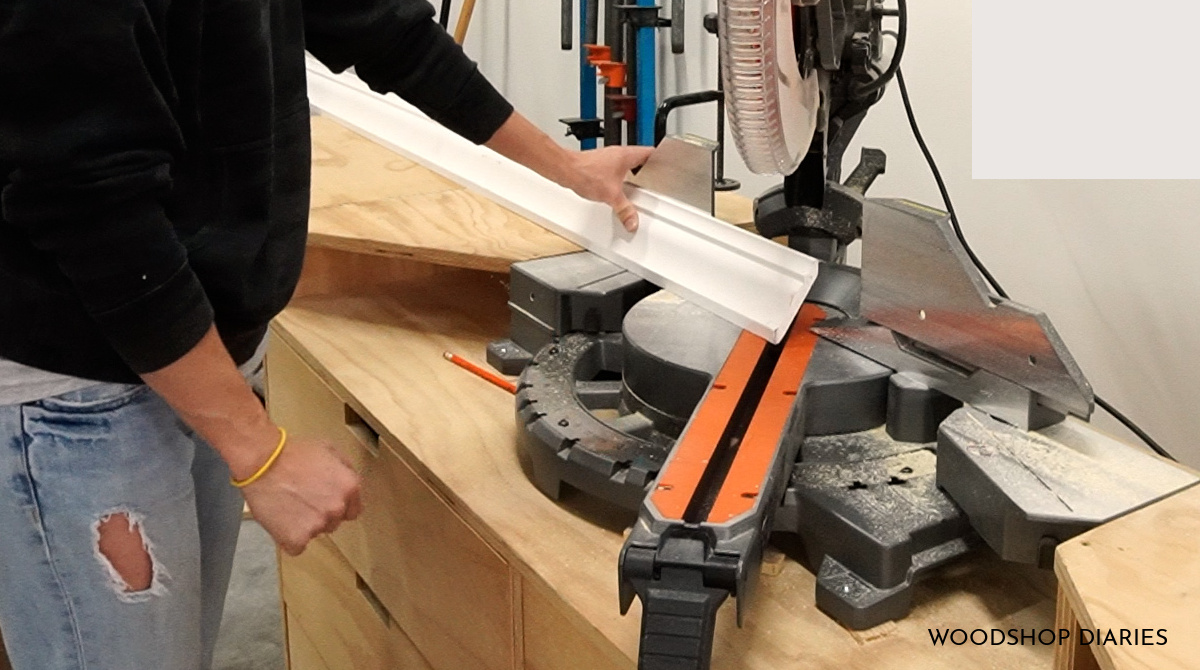Crown molding is a decorative element often used in rooms with high ceilings. It can be challenging to cut crown molding, but it’s possible with a miter saw. The key is to make sure the blade is sharp and set at the correct angle.
To cut crown molding, start by measuring the wall and cutting the molding to size. Next, mark the angles on the molding using a protractor. Then, set your miter saw to the appropriate angle and make the cuts.
Be sure to test fit the pieces before glue or nails are applied.
- Place the molding upside down and flat on the saw table
- Set the blade to 45 degrees
- Line up the blade with the mark on the molding
- Push the molding into the blade to make the cut

Credit: www.woodshopdiaries.com
Can You Cut Crown Molding With a Regular Miter Saw?
Crown molding is a type of decorative trim used to finish the tops of walls and cabinetry. It typically has a profile that includes a curved or scalloped edge, which gives it a more ornate look than traditional baseboard molding. While you can cut crown molding with a regular miter saw, it’s not the ideal tool for the job.
A miter saw is designed to make cuts at 90-degree angles, but crown molding is usually installed at an angle that’s slightly less than 90 degrees. This means that you’ll have to adjust the blade on your miter saw in order to make accurate cuts. If you don’t have experience using a miter saw, it’s best to leave this job to a professional carpenter or handyman.
What Angle Do You Set a Miter Saw for Crown Molding?
When cutting crown molding, the miter saw must be set at a particular angle to get the correct cut. The specific angle will depend on the style of crown molding being used. For example, if you are using standard crown molding with a 45-degree spring angle, then you would set the miter saw at 45 degrees.
However, if you are using crown molding with a 52-degree spring angle, then you would need to set the miter saw at 36 degrees.
Why is 31.6 on a Miter Saw?
If you’re a carpenter, contractor, or just someone who likes to do things around the house, chances are you’ve used a miter saw before. Miter saws are great for making clean, precise cuts at different angles, but have you ever wondered why the most common miter angle is 31.6 degrees? In this blog post, we’ll take a look at why 31.6 is such an important miter angle and how it can be used in your next project.
So why is 31.6 on a miter saw? The answer lies in geometry and trigonometry. To understand why 31.6 is such an important angle, we need to first take a look at what happens when we make a cut at that angle.
When cutting at 31.6 degrees, the blade of the miter saw forms two equal triangles with the wood that’s being cut. These two triangles are then combined to create a perfect 90 degree corner – which is exactly what we want when making cuts for molding or trim work.
Now that we know WHY 31.6 degrees is so important, let’s talk about HOW to use it in your next project.
How Do You Cut Crown Molding for Beginners?
If you’re a beginner at cutting crown molding, there are a few things you need to know in order to get started. First, you’ll need to determine what type of crown molding you have. There are two types of crown molding – inside and outside corner pieces.
You’ll also need to decide on the size of your crown molding. Crown molding comes in various sizes, so it’s important to select the right size for your project.
Once you’ve determined the type and size of your crown molding, it’s time to start cutting.
The first step is to cut a 45-degree angle on one end of the molding piece. Next, measure and mark where you want your cuts to be made on the other end of the piece. Be sure to use a level when making your marks so that your cuts will be even.
Finally, use a saw (either hand-held or electric) to make your cuts along the marked lines.
And that’s it! With these simple steps, you can successfully cut crown molding for any project – no matter how big or small.
Using a Miter Saw to Cut Crown Molding
Cutting 45 Degree Crown Molding Flat
If you’re looking to add a touch of elegance to your home, cutting 45 degree crown molding flat is a great way to do it. Crown molding is a type of wood trim that’s used to cover the junction between a wall and ceiling. It’s typically made from either pine or hardwood, and comes in a variety of sizes and styles.
When it comes to cutting crown molding, there are two main methods: miter cuts and cope cuts. Miter cuts are made at an angle, while cope cuts are made flush with the wall. Both methods have their own benefits and drawbacks, so it’s important to choose the one that best suits your needs.
Miter cuts are generally considered easier for beginners, as they don’t require any special tools or techniques. However, they can be more difficult to get right, as even small inaccuracies can result in noticeable gaps. Cope cuts tend to be more difficult to execute, but produce neater results overall.
If you’re planning on doing some 45 degree crown molding flat cutting, here are a few tips to help you get started:
– Use a miter saw for best results.
Conclusion
If you’re looking to add a touch of luxury to your home, one way to do it is by installing crown molding. Crown molding can be tricky to install, but with the right tools and a little bit of know-how, it’s not as difficult as it looks. One of the most important tools you’ll need for this project is a miter saw.
A miter saw is a type of power tool that allows you to make precise cuts at any angle. When cutting crown molding, you’ll need to make both 45 degree and 22.5 degree cuts. If you don’t have a miter saw, you can rent one from your local hardware store or home improvement center.
Before you start cutting, measure the length of each wall where you’ll be installing the crown molding. Cut each piece of molding slightly longer than needed so that you have some wiggle room when making your cuts. When cutting crown molding with a miter saw, always use sharp blades.
Dull blades will cause the wood to split and will make your job much more difficult.
Table of Contents

